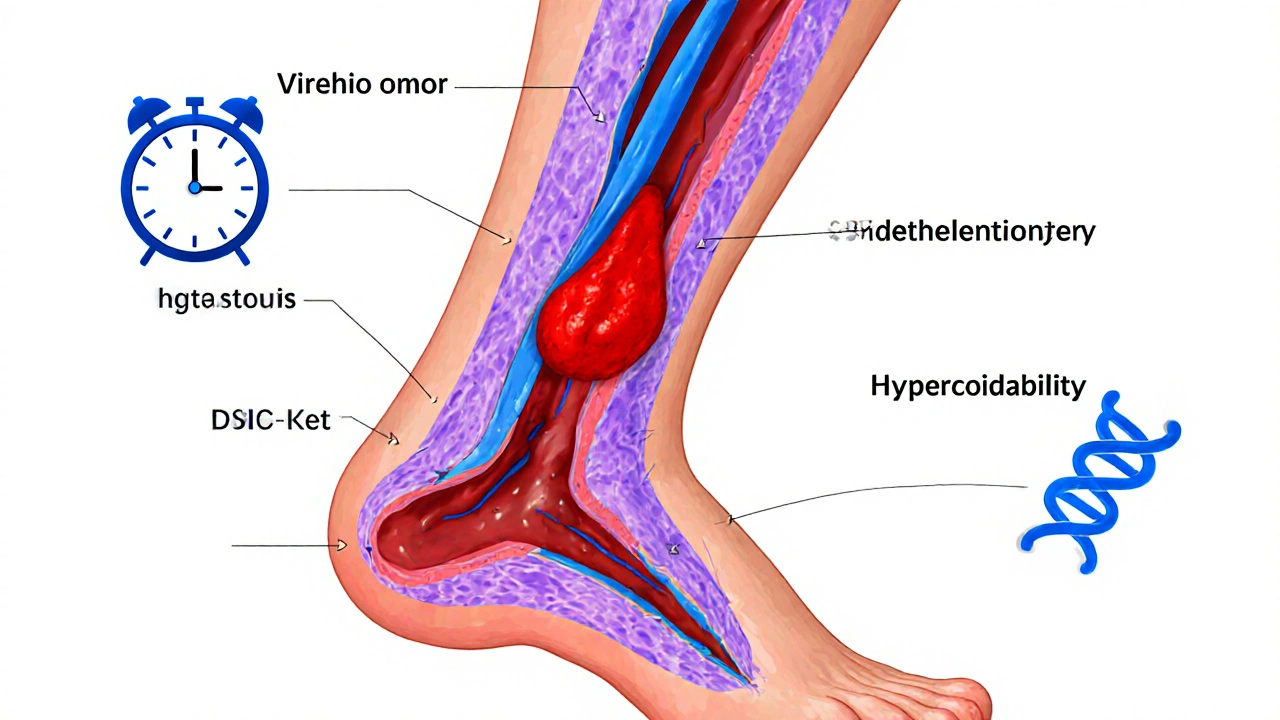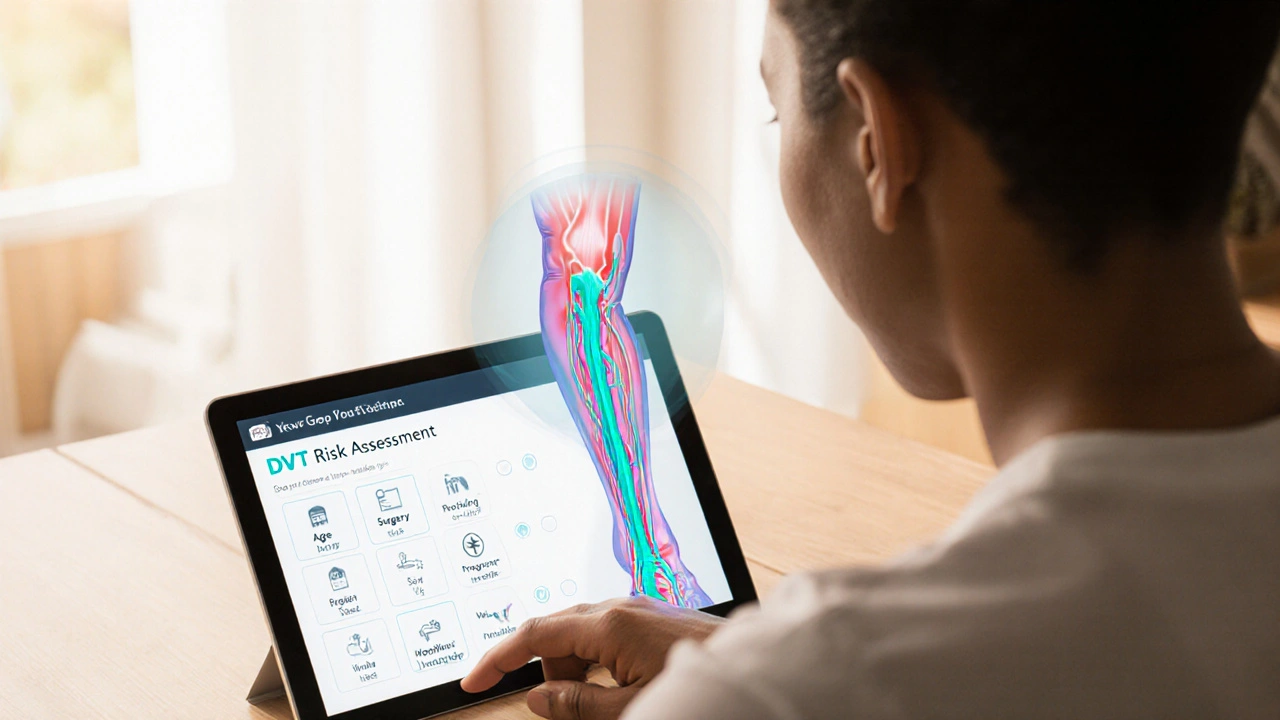DVT Risk Assessment Tool
This tool helps you understand your risk factors for developing Deep Vein Thrombosis (DVT). Answer the questions below to get personalized risk feedback.
Your Risk Assessment:
blood clot in the leg can be scary, but knowing what to look for and how it’s treated makes a huge difference. Below you’ll find a quick‑hit list of the essentials, followed by a deep dive into causes, signs, diagnosis, treatment, and prevention.
Quick Facts
- Blood clots in the lower limbs are most often called Deep Vein Thrombosis (DVT).
- Key symptoms: swelling, pain, warmth, and red‑purple skin discoloration.
- Major risk factors: prolonged sitting, recent surgery, pregnancy, cancer, and inherited clotting disorders.
- Diagnosis is usually confirmed with a venous ultrasound.
- First‑line treatment is an anticoagulant medication followed by lifestyle changes.
What Is a Blood Clot in the Leg?
When a blood clot forms in a deep vein of the calf or thigh, doctors refer to it as a blockage that can stop blood from flowing back to the heart. If part of the clot breaks off, it can travel to the lungs and cause a pulmonary embolism, a life‑threatening emergency.
How DVT Happens: The Underlying Mechanism
Virchow’s triad explains why clots form:
- Stasis: Blood slows down during long flights, car rides, or bed rest after surgery.
- Endothelial injury: Vein walls can be damaged by trauma, IV lines, or inflammatory conditions.
- Hypercoagulability: Some people have genetic mutations (e.g., Factor V Leiden) or take medications (like estrogen) that make their blood clot more easily.
When two or more of these factors line up, a clot can grow quickly.
Common Symptoms to Watch For
Not every leg ache means DVT, but these signs should raise an alarm:
- Pain or cramping that starts in the calf and feels worse when you walk.
- Visible swelling-often one leg looks larger than the other.
- Skin that feels warm or looks reddish‑purple.
- Sudden shortness of breath, rapid heartbeat, or coughing up blood (possible pulmonary embolism).
If you notice any combination of these, contact a healthcare professional right away.
Who Is at Risk? Key Risk Factors
Understanding your personal risk helps you stay ahead. The most common contributors include:
- Immobility: long‑haul flights, desk jobs, or post‑operative bed rest.
- Recent major surgery, especially orthopedic procedures on the hips or knees.
- Pregnancy and the first six weeks postpartum, due to hormonal changes and pressure on pelvic veins.
- Cancer, especially active or metastatic disease, which raises clot‑forming proteins.
- Inherited clotting disorders such as Factor V Leiden or Prothrombin G20210A.
- Obesity, smoking, and hormone replacement therapy.
Even younger, active people can develop a clot if they combine several of these factors.

How Doctors Diagnose a Leg Clot
The diagnostic pathway is quick and non‑invasive in most settings.
- Physical exam: doctors compare leg circumference and look for tenderness.
- Risk‑assessment scoring: tools like the Wells score estimate pre‑test probability.
- D‑dimer blood test: high levels suggest clotting activity, but a normal result can rule out DVT in low‑risk patients.
- If suspicion remains, a real‑time compression ultrasound visualises the vein and detects any blockage.
In rare cases, a CT or MR venography is ordered when ultrasound findings are inconclusive.
Treatment Options: From Medication to Procedures
Once confirmed, treatment aims to stop the clot from growing, prevent new clots, and reduce the risk of a pulmonary embolism.
Anticoagulant Medications
These drugs thin the blood rather than dissolve the clot. The most common classes are:
| Drug | Route | Onset | Monitoring Needed? | Typical Duration |
|---|---|---|---|---|
| Heparin (unfractionated) | IV or subcutaneous | Minutes | Yes - aPTT | 5-10 days (bridge to oral) |
| Low‑Molecular‑Weight Heparin (LMWH) | Subcutaneous | Hours | No routine | 5-10 days (bridge) |
| Warfarin | Oral | 48‑72 hours | Yes - INR | 3‑6 months or longer |
| Direct Oral Anticoagulants (DOACs) - apixaban, rivaroxaban | Oral | 2‑4 hours | No | 3‑6 months or longer |
DOACs have become first‑line in many guidelines because they don’t require regular blood tests.
Thrombolysis and Mechanical Removal
For massive clots causing severe swelling or threatening limb loss, doctors may use clot‑busting drugs (tPA) delivered via a catheter, or a mechanical device that breaks the clot apart. These are higher‑risk procedures and reserved for serious cases.
Compression Stockings
After the acute phase, graduated compression stockings (15‑30mmHg) reduce swelling and lower the chance of post‑thrombotic syndrome, a chronic pain condition.
Preventing Future Clots
Prevention blends medical advice with everyday habits:
- Move regularly: stand up and walk for a few minutes every hour during long flights or desk work.
- Stay hydrated: avoid excessive alcohol or caffeine that can thicken blood.
- Exercise: low‑impact activities like walking, cycling, or swimming improve circulation. Aim for 150minutes of moderate activity per week.
- Wear loose clothing around the waist and legs to avoid restricting blood flow.
- If you’re undergoing surgery, discuss prophylactic anticoagulation with your surgeon.
- For high‑risk individuals, a low‑dose aspirin or a scheduled DOAC may be prescribed long‑term.
When to Call Emergency Services
Time is critical if a clot travels to the lungs. Seek immediate help if you experience any of the following:
- Sudden shortness of breath or chest pain that worsens with deep breaths. \n
- Rapid heart rate (over 100bpm) or feeling light‑headed.
- Coughing up pink‑tinged sputum.
- Unexplained loss of consciousness.
Call 999 (UK) or go to the nearest Emergency Department.
Living with a History of DVT
Most people recover fully, but a prior clot raises the chance of another. Keep these habits:
- Take any prescribed anticoagulant exactly as directed.
- Schedule regular check‑ups to monitor clotting status.
- Maintain a healthy weight and quit smoking.
- Discuss any new medications with your GP, as some over‑the‑counter drugs (like NSAIDs) can interfere with anticoagulants.
With vigilant care, you can minimise future risk and stay active.
Frequently Asked Questions
Can a DVT resolve on its own without treatment?
Rarely. Small clots may dissolve slowly, but the risk of a pulmonary embolism remains high. Medical guidance is essential.
How long do I need to wear compression stockings?
Typically 2‑3months after the clot resolves, but some doctors recommend up to a year for high‑risk patients.
Is it safe to travel by plane after a DVT diagnosis?
You can travel if you’re on anticoagulants and follow preventive steps: move every hour, wear compression socks, and stay hydrated. Ask your doctor for a travel clearance.
What diet supports clot prevention?
A balanced diet rich in leafy greens, omega‑3 fatty acids (salmon, walnuts), and low in processed sugars helps keep blood thin. Limit excessive vitaminK‑rich foods only if you’re on warfarin and under medical supervision.
Can I exercise while on anticoagulants?
Yes, moderate activity is encouraged. Avoid high‑impact contact sports that could cause bruising or bleeding.

Amy Morris
October 2, 2025 AT 21:07When you feel that sudden heaviness in your calf, your body is sounding an alarm that cannot be ignored.
Your veins are trying to tell you that blood flow has become sluggish.
Deep vein thrombosis often begins subtly, with a feeling of tightness that many mistake for a muscle cramp.
In the early stages, the skin may turn a faint reddish‑purple, a visual cue that the underlying vessel is under stress.
Any recent long flight, surgery, or period of immobility dramatically raises this risk.
Pregnancy and hormonal therapy add another layer by altering clotting factors in the bloodstream.
Even genetic predispositions such as Factor V Leiden can tip the balance toward clot formation.
The good news is that modern anticoagulants, especially DOACs, can halt progression within hours.
Compression stockings, when worn correctly, reduce swelling and prevent post‑thrombotic syndrome.
Staying hydrated and moving every hour are simple habits that keep blood moving.
If you notice swelling that doesn’t improve after a day, seek medical attention promptly.
Early ultrasound imaging can confirm a clot in under thirty minutes, preventing unnecessary delays.
Should a clot travel to the lungs, the resulting pulmonary embolism becomes a life‑threatening emergency, underscoring the need for vigilance.
Doctors may prescribe a low‑dose aspirin for long‑term risk reduction in high‑risk patients.
Ultimately, awareness and proactive lifestyle changes empower you to mitigate this hidden danger.
Francesca Roberts
October 10, 2025 AT 18:01Oh great, another DVT guide, just what we needed, sooo helpful.
Becky Jarboe
October 18, 2025 AT 14:54Deep vein thrombosis is a classic example of Virchow’s triad in action, where stasis, endothelial injury, and hypercoagulability converge.
Understanding the pathophysiology helps you target interventions effectively.
For patients with recent orthopedic surgery, low‑molecular‑weight heparin remains the gold standard for early prophylaxis.
When transitioning to oral agents, direct oral anticoagulants streamline therapy by eliminating routine INR monitoring.
Remember to educate patients about the importance of ambulation; even short walks every hour hugely reduce stasis.
Incorporating compression devices during hospital stays can further lower incidence rates.
Adherence to a structured follow‑up plan ensures early detection of any recurrent events.
Carl Boel
October 26, 2025 AT 11:47Responsibility for personal health cannot be outsourced to endless medical jargon; citizens must prioritize movement over couch‑potato complacency.
Shuvam Roy
November 3, 2025 AT 08:41Your effort to understand DVT risk is commendable, and adopting small habits can make a big difference.
Set a timer to stand and stretch every hour, especially during long virtual meetings.
Hydration is key; keep a water bottle at your desk as a visual reminder.
When traveling, wear graduated compression socks and take short walks in the aisle.
If you have a recent surgery, discuss prophylactic anticoagulation with your surgeon ahead of time.
These proactive steps empower you to stay safe while maintaining an active lifestyle.
Jane Grimm
November 11, 2025 AT 05:34The composition of this guide, while exhaustive, occasionally lapses into verbosity that obscures key take‑aways.
Nevertheless, the inclusion of concrete risk‑assessment tools and clear preventive measures is praiseworthy.
One might suggest a succinct executive summary for clinicians pressed for time.
Overall, the balance between pathophysiology and practical advice is well‑maintained.